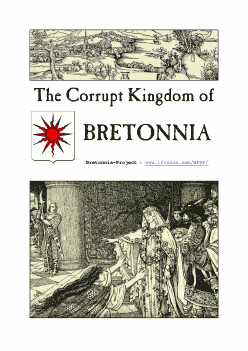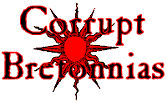¤ Bretonnia-Sourcebook
 "The
corrupt kingdom of Bretonnia" is a complete non-arthurian Bretonnian
sourcebook for WFRP. It expands on the description of
Bretonnia given in the original
WFRP
rulebook p274 to 277 rather than
the background of current Warhammer Battle.
"The
corrupt kingdom of Bretonnia" is a complete non-arthurian Bretonnian
sourcebook for WFRP. It expands on the description of
Bretonnia given in the original
WFRP
rulebook p274 to 277 rather than
the background of current Warhammer Battle.

The Corrupt Kingdom of Bretonnia (2003)
freely distributable, 200 pages in pdf format, complete with maps
and
illustrations.
Bretonnia-Sourcebook contains a lot of information specifically
intended for GMs of WFRP-Bretonnia campaigns. As a casual browser or if
you want to get a feel of the background for a 1-off game, I would
recommend starting by the following articles :
- The back-cover text
- Book1
contains a wealth of readily usable information for Bretonnian GMs and
players (Calendar, maps, timeline,
names, language, money, non-human,
cities) and will be expanded on in this website.
- Xavier Rousseau's gazette articles in Book6 are good to pass on
key elements of the Bretonnian background (Excerpts
on nobility & magic).
- The summary on government
members and noble factions at the end of Book3a gives the essential
information on who rules the nation.
- Book2 contains material for GMs wishing to play in
archaic Bretonnia, possibly with elements of WFB.
- Book5 contains expanded background for the city of Guisoreux,
the capital of Bretonnia.
- Finally books 3&4 deal with Nobility and Religion, two key
elements in Bretonnian campaigns. Saints can be used to get
PCs more involved in the faith aspect of their characters.
Peter Butterworth, Sourcebook Editor
Presentation of Bretonnia

What is Bretonnia ? Bretonnia is essentially WFRP France. It is a
decadent ancient-regime setting with swashbucklers and witches.
- Historical inspiration (French and European history)
- Medieval Period : 100 years War (Henry V, the battle of
Agincourt 1415)
- Renaissance Period : Wars of Religion (second half of the 16th
Century, St-barthelomew's massacre)
- Some anachronistic elements from Pre-revolutionary France,
absolute monarchy, philosophers, Versailles palace and the French
Revolution (1789).
- French Culture
- Swashbucklers, for instance the King's Musketeers made popular
by Dumas
- 17th Century Theatre (Comedies by Molière,
tragi-comedies by
Corneille)
- Fairy Tales and surrealism (La belle et la bête movie by
Cocteau)
- The art of Callot and De la Tour.
- Fantasy elements
- Magic and wizards
- Non-humans (elves, dwarves, halflings)
- Greenskins, skaven, undead, and the occasional monster
- Chaos
(though the Chaos theme is far less prevalent than in the
Empire)
¤ In Search of Bretonnia
23-05-2005

 "The
corrupt kingdom of Bretonnia" is a complete non-arthurian Bretonnian
sourcebook for WFRP. It expands on the description of
Bretonnia given in the original
WFRP
rulebook p274 to 277 rather than
the background of current Warhammer Battle.
"The
corrupt kingdom of Bretonnia" is a complete non-arthurian Bretonnian
sourcebook for WFRP. It expands on the description of
Bretonnia given in the original
WFRP
rulebook p274 to 277 rather than
the background of current Warhammer Battle.
